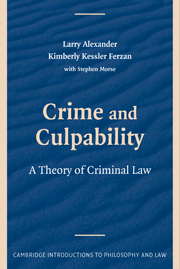8 - What a Culpability-Based Criminal Code Might Look Like
Published online by Cambridge University Press: 05 June 2012
Summary
To us, there is really only one injunction that is relevant to criminal culpability: choose only those acts for which the risks to others' interests – as you estimate those risks – are sufficiently low to be outweighed by the interests, to yourself and others, that you are attempting to advance (discounted by the probability of advancing those interests). In Model Penal Code parlance, we have done away with the special part of the criminal code. We have a general rule that applies to all crimes, not specific rules of conduct.
Our view of culpability is not the end of the matter, however. Even our idealized code has a significant amount of work to do. The criminal law must identify those interests that it will protect. In addition, the criminal law must have a system for adjudicating the actor's culpability, which must determine not just what harms the actor is aware he is risking but also his estimate of the probability of those harms obtaining. Moreover, in adjudicating culpability, the criminal law must balance this estimate against the actor's reasons for acting, which must also be discounted by the actor's estimate that those reasons will obtain. And if the determination of that balance reveals that the actor's action is unjustifiable, the assessment of the actor's culpability is still not complete. For, as we have noted, the criminal law must also assess the quality of the actor's deliberation – a factor that can either mitigate or aggravate the actor's culpability.
- Type
- Chapter
- Information
- Crime and CulpabilityA Theory of Criminal Law, pp. 263 - 324Publisher: Cambridge University PressPrint publication year: 2009
- 1
- Cited by



